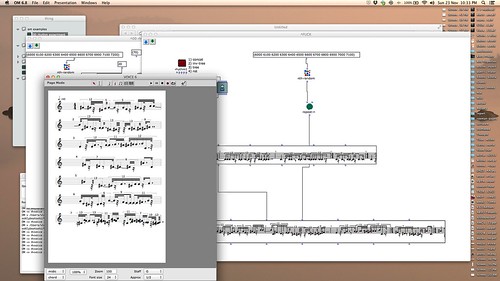Like an Actress
By fc on November 23, 2014 12:14 pm
Phwoahhh…
What a gnarly week this beat has been! First it took me ages to find a voice sample I liked, then I did about three hours patching in Open Music only to break it and have to start again, then I couldn't get MIDI exporting to work, so I had to export as XML, pipe it into Sibelius and then export the MIDI from Sibelius.
Voice slices from Susan Sontag "Side A" on Ubu Sound: http://www.ubu.com/sound/sontag.html
Cut up in Ableton.
Rhythms generated using random processes in Open Music:
 Screen Shot 2014-11-23 at 10.33.28 PM by vince-giles, on Flickr
Screen Shot 2014-11-23 at 10.33.28 PM by vince-giles, on Flickr
Synthesis is just under 8000 oscillators and is a rendering of a sonification of mass to charge ratios of silver (and some other things) from a mass spectrometry machine at a chemistry lab, where I am a composer-in-residence. It is the first such sonification that I've done, and I can tell you, it wasn't easy!
 Screen Shot 2014-11-22 at 12.52.38 PM by vince-giles, on Flickr
Screen Shot 2014-11-22 at 12.52.38 PM by vince-giles, on Flickr
Sonogram:
 amazing by vince-giles, on Flickr
amazing by vince-giles, on Flickr
Weeklybeat user Faux Foe and I did a bit of a collab using the chemistry sonification this week for her Weeklybeat, go check it out!
Audio works licensed by author under:
Copyright All rights reserved
